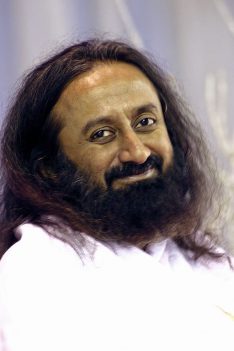
Sri Sri Ravi Shankar? Claim this page
| DOB | May 13, 1956 (67 years) |
|---|---|
| Guru | Pandit Sudhakar Chaturvedi, Maharishi Mahesh Yogi |
| Organization | Art of Living |
| Education | B.Sc (St. Joseph’s College, Bangalore) |
| Location | Bengaluru, India |
Videos
Meditations
Music
Sri Sri Ravi Shankar
Ravi Shankar was born in Papanasam, Tamil Nadu, to Vishalakshi and R.S.Venkat Ratnam. He is the brother of Bhanumathi Narasimhan. He was named “Ravi” (a common Indian name which means “sun”) because his birth was on a Sunday, and “Shankar” after the eighth-century Hindu saint, Adi Shankara, whose birthday was the same day as Ravi Shankar. Ravi Shankar’s first teacher was Sudhakar Chaturvedi, an Indian Vedic Scholar and a close associate of Mahatma Gandhi. He holds a Bachelor of Science degree from the St. Joseph’s College of Bengaluru University. After graduation, He travelled with his second teacher, Maharishi Mahesh Yogi, giving talks and arranging conferences on Vedic science, and setting up Transcendental Meditation and Ayurveda centers.
In the 1980s, He initiated a series of practical and experiential courses in spirituality around the globe. He says that his rhythmic breathing practice, Sudarshan Kriya, came to him in 1982, “like a poem, an inspiration”, after a ten-day period of silence on the banks of the Bhadra River in Shivamogga, in the state of Karnataka, adding, “I learned it and started teaching it”.
In 1983, He held the first Art of Living course in Switzerland. In 1986, he travelled to Apple Valley, California, in the US to conduct the first course to be held in North America.[14]
Philosophy and Teachings
He believes spirituality is that which enhances human values such as love, compassion and enthusiasm. It is not limited to any one religion or culture. Hence it is open to all people. He feels the spiritual bond we share as part of the human family is more prominent than nationality, gender, religion, profession, or other identities that separate us.
According to him, science and spirituality are linked and compatible, both springing from the urge to know. The question, “Who am I?” leads to spirituality; the question, “What is this?” leads to science. Emphasizing that joy is only available in the present moment, his stated vision is to create a world free of stress and violence. His programs are said to offer practical tools to help accomplish this. He sees breath as the link between body and mind, and a tool to relax the mind, emphasising the importance of both meditation/spiritual practice and service to others. In his view, “Truth is spherical rather than linear; so it has to be contradictory.”
| Book Name | Year | Language |
|---|---|---|
| An Intimate Note to the Sincere Seeker | 2021 | English |
| Notes for the Journey Within | 2023 | English |
| Be A Witness: The Wisdom of the Upanishads | 1999 | English |
| God Loves Fun | 2000 | English |
| Celebrating Silence: Excerpts from Five Years of Weekly Knowledge 1995–2000 | 2001 | English |
| मौन की गूँज | 2010 | Hindi |
| Celebrating Love | 2008 | English |
| Narada Bhakti Sutra | 2005 | English |
| Hinduism & Islam, the common thread | 2002 | English |
| Secrets of Relationships | 2014 | English |
| संबंधों के रहस्य | 2008 | Hindi |
| Patanjali Yoga Sutras | 2014 | English |
| Ashtavakra Gita | 2010 | English |
| Management Mantras | 2014 | English |
| Know Your Child: The Art of Raising Children | 2014 | English |
| कठोपनिषद | 2015 | Hindi |
| Sex, Life , Spirituality | 2017 | English |
| Ishavasya: Upanishad | 2017 | English |
| Waves Of Emotions | 2010 | English |
| Buddha: manifestation of silence | 2009 | English |